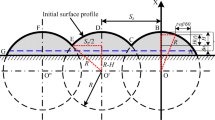Abstract
Laser cladding, which can increase the hardness and wear resistance of the used components, is widely used in remanufacture and sustainable manufacturing field. Generally, laser cladding layer should be machined to meet the function as well as the assembly requirements. Milling is an effective means for precision machining. However, there exist great differences of physical and mechanical performances between laser cladding layer and substrate material, such as microstructure, hardness, mechanical properties, etc. This produces some new milling problems for laser cladding layer. An insightful understanding of milling mechanism of laser cladding layer is inevitable. There still lacks the research on this subject, such as chip morphology and mechanical behavior, vibration during laser cladding layer milling process, etc. Thus, the change of chip morphology depending on the cutting parameters and microhardness variation was studied. Signal analysis methods of time and frequency domains of cutting forces and machining vibration were used to evaluate the milling characteristics of laser cladding layer. The microstructural analysis indicates that shear-induced lamella structures are the basic features for the chip free surface. The height-to-thickness ratio of saw-tooth chips increases with increasing cutting speeds and feeds. Microhardness profiles on the top surfaces of machined chip decrease from the back surface to the bulk chip, and the shear band shows increased hardness. The cutting force and machining vibration acceleration of laser cladding layer are higher than those of the KMN steel substrate at the same cutting parameters. The machining vibration is characterized by high vibration in the intermediate position of each layer and low vibration in the joint surfaces between layers.
Similar content being viewed by others
References
Wang YB, Zhao SS, Gao WY, Zhou CY, Liu FL, Lin XC (2014) Microstructure and properties of laser cladding FeCrBSi composite powder coatings with higher Cr content. J Mater Process Technol 214:899–905
Ray A, Arora KS, Lester S, Shome M (2014) Laser cladding of continuous caster lateral rolls: microstructure, wear and corrosion characterisation and on-field performance evaluation. J Mater Process Technol 214:1566–1575
Chen CR, Wang Y, Ou HG, He Y, Tang XZ (2014) A review on remanufacture of dies and moulds. J Clean Prod 64:13–23
Cook NH (1953) Chip formation in machining titanium. Proceedings of the Symposium on Grinding of Titanium, Watertown Arsenal, MA, 1–7
Nakayama K (1974) The formation of saw-tooth chip. Proceedings of First International Conference on Production Engineering, Tokyo, Japan, 572–577
Vyas A, Shaw MC (1999) Mechanics of saw-tooth chip formation in metal cutting. J Manuf Sci Eng 121:163–172
König W, Berktold A, Koch KF (1993) Turning versus grinding—a comparison of surface integrity aspects and attainable accuracies. CIRP Ann 42:39–43
Elbestawi MA, Srivastava KA, El-Wardany TI (1996) A model for chip formation during machining of hardened steel. CIRP Ann 45:71–76
Komanduri R, Schroeder T, Hazra J, Turkovich BF, Flom DG (1982) On the catastrophic shear instability in high speed machining of AISI 4340 steels. J Manuf Sci Eng 104:121–131
Davies MA, Burns TJ, Evans CJ (1997) On the dynamics of chip formation in machining hard metals. CIRP Ann 46:25–30
Semiatin SL, Rao SB (1983) Shear localisation during metal cutting. Mater Sci Eng 61:185–192
Hou ZB, Komanduri R (1997) Modeling of thermo-mechanical shear instability in machining. Int J Mech Sci 39:1273–1314
Sun J, Guo YB (2008) A new multi-view approach to characterize 3D chip morphology and properties in end milling titanium Ti-6Al-4V. Int J Mach Tools Manuf 48:1486–1494
Zhang S, Guo YB (2009) An experimental and analytical analysis on chip morphology, phase transformation, oxidation, and their relationships in finish hard milling. Int J Mach Tools Manuf 49:805–813
Bermingham MJ, Kirsch J, Sun S, Palanisamy S, Dargusch MS (2011) New observations on tool life, cutting forces and chip morphology in cryogenic machining Ti-6Al-4V. Int J Mach Tools Manuf 51:500–511
Xu D, Feng P, Li W, Ma Y, Liu B (2014) Research on chip formation parameters of aluminum alloy 6061-T6 based on high-speed orthogonal cutting model. Int J Adv Manuf Technol 72:955–962
Wang M, Xu B, Zhang J, Dong S, Wei S (2013) Experimental observations on surface roughness, chip morphology, and tool wear behavior in machining Fe-based amorphous alloy overlay for remanufacture. Int J Adv Manuf Technol 67:1537–1548
Wan ZP, Zhu YE, Liu HW, Tang Y (2012) Microstructure evolution of adiabatic shear bands and mechanisms of saw-tooth chip formation in machining Ti6Al4V. Mater Sci Eng A 531:155–163
Li R, Riester L, Watkins TR, Blau PJ, Shin AJ (2007) Metallurgical analysis and nanoindentation characterization of Ti-6Al-4V workpiece and chips in high throughput drilling. Mater Sci Eng A 472:115–124
Frumusanu GR, Constantin IC, Marinescu V, Epureanu A (2013) Development of a stability intelligent control system for turning. Int J Adv Manuf Technol 64:643–657
Choudhury SK, Sharath MS (1995) On-line control of machine tool vibration during turning operation. J Mater Process Technol 47:251–259
Dimla DE Sr, Lister PM (2000) On-line metal cutting tool condition monitoring. I: force and vibration analyses. Int J Mach Tools Manuf 40:739–768
Huang PL, Li JF, Sun J, Zhou J (2013) Study on vibration reduction mechanism of variable pitch end mill and cutting performance in milling titanium alloy. Int J Adv Manuf Technol 67:1385–1391
Huang PL, Li JF, Sun J, Zhou J (2014) Study on performance in dry milling aeronautical titanium alloy thin-wall components with two types of tools. J Clean Prod 67:258–264
Author information
Authors and Affiliations
Corresponding authors
Rights and permissions
About this article
Cite this article
Zhao, Y., Sun, J. & Li, J. Study on chip morphology and milling characteristics of laser cladding layer. Int J Adv Manuf Technol 77, 783–796 (2015). https://doi.org/10.1007/s00170-014-6483-2
Received:
Accepted:
Published:
Issue Date:
DOI: https://doi.org/10.1007/s00170-014-6483-2




